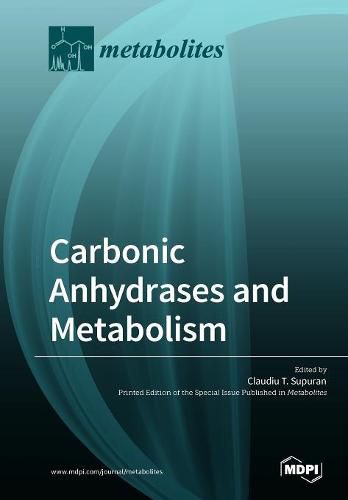Readings Newsletter
Become a Readings Member to make your shopping experience even easier.
Sign in or sign up for free!
You’re not far away from qualifying for FREE standard shipping within Australia
You’ve qualified for FREE standard shipping within Australia
The cart is loading…






This title is printed to order. This book may have been self-published. If so, we cannot guarantee the quality of the content. In the main most books will have gone through the editing process however some may not. We therefore suggest that you be aware of this before ordering this book. If in doubt check either the author or publisher’s details as we are unable to accept any returns unless they are faulty. Please contact us if you have any questions.
Carbonic anhydrases (CAs; EC 4.2.1.1) are metalloenzymes present in all kingdoms of life, as they equilibrate the reaction between three simple but essential chemical species: CO2, bicarbonate, and protons. Discovered more than 80 years ago, in 1933, these enzymes have been extensively investigated due to the biomedical application of their inhibitors, but also because they are an extraordinary example of convergent evolution, with seven genetically distinct CA families that evolved independently in Bacteria, Archaea, and Eukarya. CAs are also among the most efficient enzymes known in nature, due to the fact that the uncatalyzed hydration of CO2 is a very slow process and the physiological demands for its conversion to ionic, soluble species is very high. Inhibition of the CAs has pharmacological applications in many fields, such as antiglaucoma, anticonvulsant, antiobesity, and anticancer agents/diagnostic tools, but is also emerging for designing anti-infectives, i.e., antifungal, antibacterial, and antiprotozoan agents with a novel mechanism of action. Mitochondrial CAs are implicated in de novo lipogenesis, and thus selective inhibitors of such enzymes may be useful for the development of new antiobesity drugs. As tumor metabolism is diverse compared to that of normal cells, ultimately, relevant contributions on the role of the tumor-associated isoforms CA IX and XII in these phenomena have been published and the two isoforms have been validated as novel antitumor/antimetastatic drug targets, with antibodies and small-molecule inhibitors in various stages of clinical development. CAs also play a crucial role in other metabolic processes connected with urea biosynthesis, gluconeogenesis, and so on, since many carboxylation reactions catalyzed by acetyl-coenzyme A carboxylase or pyruvate carboxylase use bicarbonate, not CO2, as a substrate. In organisms other than mammals, e.g., plants, algae, and cyanobacteria, CAs are involved in photosynthesis, whereas in many parasites (fungi, protozoa), they are involved in the de novo synthesis of important metabolites (lipids, nucleic acids, etc.). The metabolic effects related to interference with CA activity, however, have been scarcely investigated. The present Special Issue of Metabolites aims to fill this gap by presenting the latest developments in the field of CAs and their role in metabolism.
$9.00 standard shipping within Australia
FREE standard shipping within Australia for orders over $100.00
Express & International shipping calculated at checkout
This title is printed to order. This book may have been self-published. If so, we cannot guarantee the quality of the content. In the main most books will have gone through the editing process however some may not. We therefore suggest that you be aware of this before ordering this book. If in doubt check either the author or publisher’s details as we are unable to accept any returns unless they are faulty. Please contact us if you have any questions.
Carbonic anhydrases (CAs; EC 4.2.1.1) are metalloenzymes present in all kingdoms of life, as they equilibrate the reaction between three simple but essential chemical species: CO2, bicarbonate, and protons. Discovered more than 80 years ago, in 1933, these enzymes have been extensively investigated due to the biomedical application of their inhibitors, but also because they are an extraordinary example of convergent evolution, with seven genetically distinct CA families that evolved independently in Bacteria, Archaea, and Eukarya. CAs are also among the most efficient enzymes known in nature, due to the fact that the uncatalyzed hydration of CO2 is a very slow process and the physiological demands for its conversion to ionic, soluble species is very high. Inhibition of the CAs has pharmacological applications in many fields, such as antiglaucoma, anticonvulsant, antiobesity, and anticancer agents/diagnostic tools, but is also emerging for designing anti-infectives, i.e., antifungal, antibacterial, and antiprotozoan agents with a novel mechanism of action. Mitochondrial CAs are implicated in de novo lipogenesis, and thus selective inhibitors of such enzymes may be useful for the development of new antiobesity drugs. As tumor metabolism is diverse compared to that of normal cells, ultimately, relevant contributions on the role of the tumor-associated isoforms CA IX and XII in these phenomena have been published and the two isoforms have been validated as novel antitumor/antimetastatic drug targets, with antibodies and small-molecule inhibitors in various stages of clinical development. CAs also play a crucial role in other metabolic processes connected with urea biosynthesis, gluconeogenesis, and so on, since many carboxylation reactions catalyzed by acetyl-coenzyme A carboxylase or pyruvate carboxylase use bicarbonate, not CO2, as a substrate. In organisms other than mammals, e.g., plants, algae, and cyanobacteria, CAs are involved in photosynthesis, whereas in many parasites (fungi, protozoa), they are involved in the de novo synthesis of important metabolites (lipids, nucleic acids, etc.). The metabolic effects related to interference with CA activity, however, have been scarcely investigated. The present Special Issue of Metabolites aims to fill this gap by presenting the latest developments in the field of CAs and their role in metabolism.